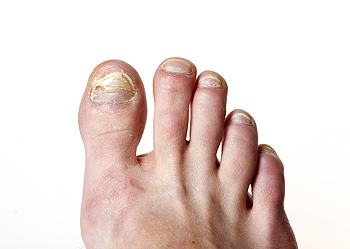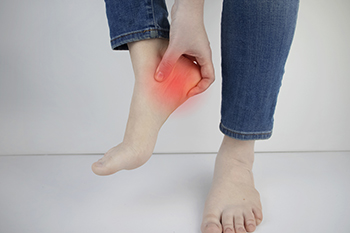Connect With Us
Blog
Items filtered by date: July 2024
Treatments for Nail Fungus

Dealing with nail fungus can be more than just a cosmetic concern. It can affect your comfort and confidence. Symptoms often start subtly with discoloration, usually yellow or brown, and thickening of the nail. As the infection progresses, nails may become brittle, crumbly, or even emit a foul odor. Beyond appearance, nail fungus can cause discomfort. Nails might feel tender or sore, especially when wearing shoes or applying pressure. In severe cases, it can lead to difficulty walking or performing daily activities. Effective treatments range from over-the-counter antifungal creams to prescription medications or nail lacquers. Maintaining good foot hygiene, wearing breathable footwear, and avoiding shared pedicure tools can help prevent recurrence. If you suspect nail fungus, do not delay seeking professional advice. It is suggested that you make an appointment with a podiatrist who can accurately diagnose the infection and recommend the best course of treatment.
If left untreated, toenail fungus may spread to other toenails, skin, or even fingernails. If you suspect you have toenail fungus it is important to seek treatment right away. For more information about treatment, contact Jeffrey Rosenblatt, DPM of New York. Our doctor can provide the care you need to keep you pain-free and on your feet.
Symptoms
- Warped or oddly shaped nails
- Yellowish nails
- Loose/separated nail
- Buildup of bits and pieces of nail fragments under the nail
- Brittle, broken, thickened nail
Treatment
If self-care strategies and over-the-counter medications does not help your fungus, your podiatrist may give you a prescription drug instead. Even if you find relief from your toenail fungus symptoms, you may experience a repeat infection in the future.
Prevention
In order to prevent getting toenail fungus in the future, you should always make sure to wash your feet with soap and water. After washing, it is important to dry your feet thoroughly especially in between the toes. When trimming your toenails, be sure to trim straight across instead of in a rounded shape. It is crucial not to cover up discolored nails with nail polish because that will prevent your nail from being able to “breathe”.
In some cases, surgical procedure may be needed to remove the toenail fungus. Consult with your podiatrist about the best treatment options for your case of toenail fungus.
If you have any questions, please feel free to contact our office located in Brooklyn, NY . We offer the newest diagnostic and treatment technologies for all your foot care needs.
Causes and Relief From Plantar Fasciitis

Plantar fasciitis is a common condition characterized by inflammation of the plantar fascia, a thick band of tissue that runs along the bottom of the foot. Symptoms often include sharp heel pain, especially in the morning or after long periods of rest. Causes of plantar fasciitis can vary, with overpronation, where the foot rolls inward excessively, being a significant factor. Additionally, differences in leg length can contribute to uneven stress on the feet. Relief options are available, including stretching exercises, orthotic supports, and proper footwear. Using anti-inflammatory medications can also help alleviate pain. If you have heel pain, it is strongly suggested that you consult a podiatrist who can successfully treat plantar fasciitis.
Plantar fasciitis can be very painful and inconvenient. If you are experiencing heel pain or symptoms of plantar fasciitis, contact Jeffrey Rosenblatt, DPM from New York. Our doctor can provide the care you need to keep you pain-free and on your feet.
What Is Plantar Fasciitis?
Plantar fasciitis is the inflammation of the thick band of tissue that runs along the bottom of your foot, known as the plantar fascia, and causes mild to severe heel pain.
What Causes Plantar Fasciitis?
- Excessive running
- Non-supportive shoes
- Overpronation
- Repeated stretching and tearing of the plantar fascia
How Can It Be Treated?
- Conservative measures – anti-inflammatories, ice packs, stretching exercises, physical therapy, orthotic devices
- Shockwave therapy – sound waves are sent to the affected area to facilitate healing and are usually used for chronic cases of plantar fasciitis
- Surgery – usually only used as a last resort when all else fails. The plantar fascia can be surgically detached from the heel
While very treatable, plantar fasciitis is definitely not something that should be ignored. Especially in severe cases, speaking to your doctor right away is highly recommended to avoid complications and severe heel pain. Your podiatrist can work with you to provide the appropriate treatment options tailored to your condition.
If you have any questions please feel free to contact our office located in Brooklyn, NY . We offer the newest diagnostic and treatment technologies for all your foot and ankle needs.
Hammertoe Fixes
 A hammertoe is a deformity that causes one of the toes, typically the second, third, or fourth, to bend downward at the middle joint, resembling a hammer. This condition often results from an imbalance in the muscles, tendons, or ligaments that hold the toe straight, and it can be exacerbated by wearing tight or ill-fitting shoes. Arthritis, injury, or a genetic predisposition can also contribute to its development. Hammertoes can be painful, especially while walking or wearing shoes. They may cause corns or calluses to form on the top of the joint or at the tip of the toe due to constant friction. If left untreated, hammertoes can lead to more severe complications, such as open sores or difficulty in walking. Relief options include wearing proper footwear with a roomy toe box, using orthotic inserts, and performing toe exercises to strengthen and stretch the muscles. In severe cases, surgical intervention may be necessary to correct the deformity. If you have a hammertoe that is causing you discomfort, it is suggested that you schedule an appointment with a podiatrist for the best treatment plan.
A hammertoe is a deformity that causes one of the toes, typically the second, third, or fourth, to bend downward at the middle joint, resembling a hammer. This condition often results from an imbalance in the muscles, tendons, or ligaments that hold the toe straight, and it can be exacerbated by wearing tight or ill-fitting shoes. Arthritis, injury, or a genetic predisposition can also contribute to its development. Hammertoes can be painful, especially while walking or wearing shoes. They may cause corns or calluses to form on the top of the joint or at the tip of the toe due to constant friction. If left untreated, hammertoes can lead to more severe complications, such as open sores or difficulty in walking. Relief options include wearing proper footwear with a roomy toe box, using orthotic inserts, and performing toe exercises to strengthen and stretch the muscles. In severe cases, surgical intervention may be necessary to correct the deformity. If you have a hammertoe that is causing you discomfort, it is suggested that you schedule an appointment with a podiatrist for the best treatment plan.
Hammertoes can be a painful condition to live with. For more information, contact Jeffrey Rosenblatt, DPM of New York. Our doctor will answer any of your foot- and ankle-related questions.
Hammertoe
Hammertoe is a foot deformity that occurs due to an imbalance in the muscles, tendons, or ligaments that normally hold the toe straight. It can be caused by the type of shoes you wear, your foot structure, trauma, and certain disease processes.
Symptoms
- Painful and/or difficult toe movement
- Swelling
- Joint stiffness
- Calluses/Corns
- Physical deformity
Risk Factors
- Age – The risk of hammertoe increases with age
- Sex – Women are more likely to have hammertoe compared to men
- Toe Length – You are more likely to develop hammertoe if your second toe is longer than your big toe
- Certain Diseases – Arthritis and diabetes may make you more likely to develop hammertoe
Treatment
If you have hammertoe, you should change into a more comfortable shoe that provides enough room for your toes. Exercises such as picking up marbles may strengthen and stretch your toe muscles. Nevertheless, it is important to seek assistance from a podiatrist in order to determine the severity of your hammertoe and see which treatment option will work best for you.
If you have any questions, please feel free to contact our office located in Brooklyn, NY . We offer the newest diagnostic and treatment technologies for all your foot care needs.
Podiatrists Are Essential for Golfers
 Plantar fasciitis is a common foot condition in golfers due to the prolonged periods of standing and walking involved in the game. Regular foot stretches can help prevent this painful condition. Before hitting the golf course, it is beneficial to perform calf stretches by leaning against a wall with one foot forward and the other extended back. Stretching the arch of the foot by rolling a golf ball under it can also be effective. Additionally, toe stretches, where you pull your toes back towards your shin, help maintain flexibility in the plantar fascia. Incorporating these stretches into your routine not only reduces the risk of plantar fasciitis but also enhances overall foot comfort and performance on the course. Consistent stretching ensures that your feet are well-prepared for the demands of a round of golf. It is also helpful to wear shoes that have adequate arch support or to add orthotics to existing shoes, if needed. If you have developed heel pain while playing golf, it is suggested that you visit a podiatrist who can diagnose and treat plantar fasciitis.
Plantar fasciitis is a common foot condition in golfers due to the prolonged periods of standing and walking involved in the game. Regular foot stretches can help prevent this painful condition. Before hitting the golf course, it is beneficial to perform calf stretches by leaning against a wall with one foot forward and the other extended back. Stretching the arch of the foot by rolling a golf ball under it can also be effective. Additionally, toe stretches, where you pull your toes back towards your shin, help maintain flexibility in the plantar fascia. Incorporating these stretches into your routine not only reduces the risk of plantar fasciitis but also enhances overall foot comfort and performance on the course. Consistent stretching ensures that your feet are well-prepared for the demands of a round of golf. It is also helpful to wear shoes that have adequate arch support or to add orthotics to existing shoes, if needed. If you have developed heel pain while playing golf, it is suggested that you visit a podiatrist who can diagnose and treat plantar fasciitis.
Sports related foot and ankle injuries require proper treatment before players can go back to their regular routines. For more information, contact Jeffrey Rosenblatt, DPM of New York. Our doctor can provide the care you need to keep you pain-free and on your feet.
Sports Related Foot and Ankle Injuries
Foot and ankle injuries are a common occurrence when it comes to athletes of any sport. While many athletes dismiss the initial aches and pains, the truth is that ignoring potential foot and ankle injuries can lead to serious problems. As athletes continue to place pressure and strain the area further, a mild injury can turn into something as serious as a rupture and may lead to a permanent disability. There are many factors that contribute to sports related foot and ankle injuries, which include failure to warm up properly, not providing support or wearing bad footwear. Common injuries and conditions athletes face, including:
- Plantar Fasciitis
- Plantar Fasciosis
- Achilles Tendinitis
- Achilles Tendon Rupture
- Ankle Sprains
Sports related injuries are commonly treated using the RICE method. This includes rest, applying ice to the injured area, compression and elevating the ankle. More serious sprains and injuries may require surgery, which could include arthroscopic and reconstructive surgery. Rehabilitation and therapy may also be required in order to get any recovering athlete to become fully functional again. Any unusual aches and pains an athlete sustains must be evaluated by a licensed, reputable medical professional.
If you have any questions please feel free to contact our office located in Brooklyn, NY . We offer the newest diagnostic and treatment technologies for all your foot and ankle needs.
Let the Expert Treat Your Ingrown Toenails
Tarsal Tunnel Syndrome Causes Heel Pain
 Heel pain is a common complaint that can significantly impact daily activities. Heel pain often stems from tarsal tunnel syndrome, where the tibial nerve gets squeezed within the tight passage along the inner ankle, known as the tarsal tunnel. This compression can occur due to injury, swelling, or structural issues like flat feet. Symptoms of tarsal tunnel syndrome include numbness or tingling in the heel, arch, or sole of the foot. This condition can be irritated by activities that put immense pressure on the foot, such as standing or walking for prolonged periods. Treatment options for tarsal tunnel syndrome include rest, ice therapy, and in severe cases, surgery to relieve pressure on the affected nerve. If this condition is left untreated, tarsal tunnel syndrome can worsen, leading to chronic pain and potentially affecting mobility. If you notice any signs of tarsal tunnel syndrome or heel pain, it is suggested to schedule an appointment with a podiatrist for a proper diagnosis and treatment options.
Heel pain is a common complaint that can significantly impact daily activities. Heel pain often stems from tarsal tunnel syndrome, where the tibial nerve gets squeezed within the tight passage along the inner ankle, known as the tarsal tunnel. This compression can occur due to injury, swelling, or structural issues like flat feet. Symptoms of tarsal tunnel syndrome include numbness or tingling in the heel, arch, or sole of the foot. This condition can be irritated by activities that put immense pressure on the foot, such as standing or walking for prolonged periods. Treatment options for tarsal tunnel syndrome include rest, ice therapy, and in severe cases, surgery to relieve pressure on the affected nerve. If this condition is left untreated, tarsal tunnel syndrome can worsen, leading to chronic pain and potentially affecting mobility. If you notice any signs of tarsal tunnel syndrome or heel pain, it is suggested to schedule an appointment with a podiatrist for a proper diagnosis and treatment options.
Many people suffer from bouts of heel pain. For more information, contact Jeffrey Rosenblatt, DPM of New York. Our doctor can provide the care you need to keep you pain-free and on your feet.
Causes of Heel Pain
Heel pain is often associated with plantar fasciitis. The plantar fascia is a band of tissues that extends along the bottom of the foot. A rip or tear in this ligament can cause inflammation of the tissue.
Achilles tendonitis is another cause of heel pain. Inflammation of the Achilles tendon will cause pain from fractures and muscle tearing. Lack of flexibility is also another symptom.
Heel spurs are another cause of pain. When the tissues of the plantar fascia undergo a great deal of stress, it can lead to ligament separation from the heel bone, causing heel spurs.
Why Might Heel Pain Occur?
- Wearing ill-fitting shoes
- Wearing non-supportive shoes
- Weight change
- Excessive running
Treatments
Heel pain should be treated as soon as possible for immediate results. Keeping your feet in a stress-free environment will help. If you suffer from Achilles tendonitis or plantar fasciitis, applying ice will reduce the swelling. Stretching before an exercise like running will help the muscles. Using all these tips will help make heel pain a condition of the past.
If you have any questions please contact our office located in Brooklyn, NY . We offer the newest diagnostic and treatment technologies for all your foot and ankle needs.
Blog Archives
- April 2025
- March 2025
- February 2025
- January 2025
- December 2024
- November 2024
- October 2024
- September 2024
- August 2024
- July 2024
- June 2024
- May 2024
- April 2024
- March 2024
- February 2024
- January 2024
- December 2023
- November 2023
- October 2023
- September 2023
- August 2023
- July 2023
- June 2023
- May 2023
- April 2023
- March 2023
- February 2023
- January 2023
- December 2022
- November 2022
- October 2022
- September 2022
- August 2022

